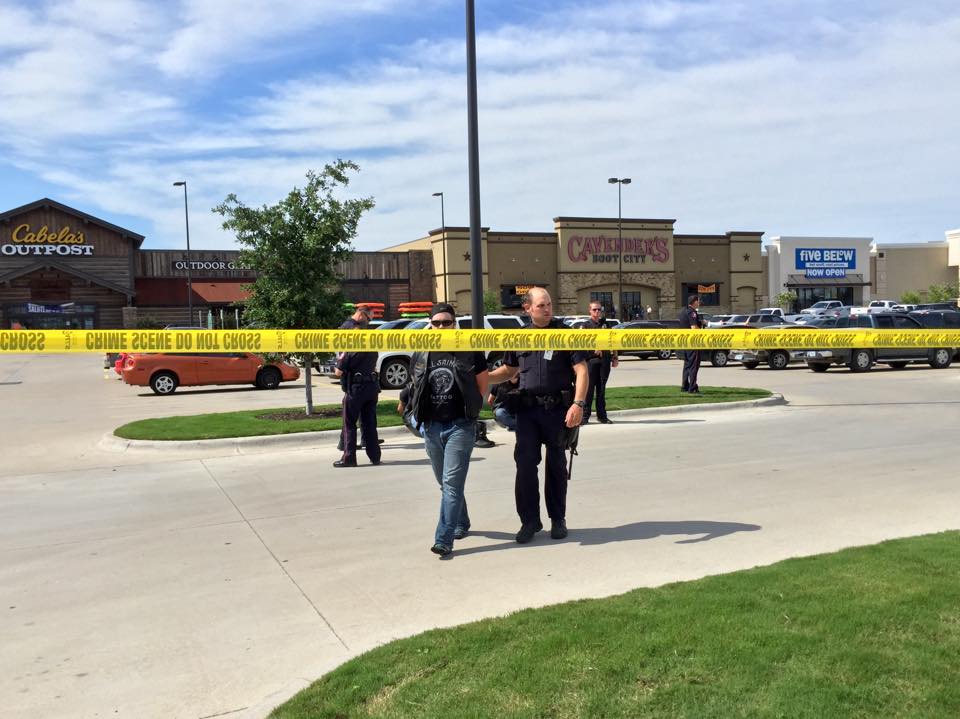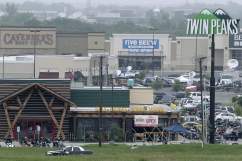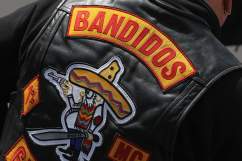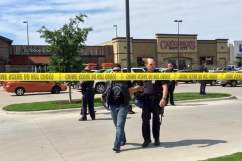
A Waco police officer leads a biker away from the scene of a shooting that left at least 9 dead and several others wounded. (Waco Police photo)
Two Texas biker gangs were at the center of a violent brawl and shootout that left 9 dead and 18 wounded Sunday afternoon in Waco, Texas.
The Bandidos, the second-largest biker gang in the world, has a history of violence in Texas since it was founded in 1966.
Gang experts say a smaller club, the Cossacks, were trying to fight against the Bandidos. The Cossacks, founded in 1969 in Tyler, Texas, showed up at a meeting of regional biker clubs that they weren’t invited to, the Bandidos claim. What started as an argument in the bathroom of the Twin Peaks restaurant spilled into the parking lot and turned deadly when fistfights led to gunfire.
The two clubs are well known in Texas and both insist that they are not gangs. In addition to alleged illegal activities, they are both known for taking part in charity events and political activism, such as advocating for motorcycle safety laws and fighting so-called discrimination against biker club members who wear patches.
According to the New York Times, eight of the nine victims were members of the Cossacks. One was with the Bandidos.
“The view of the Bandidos is that Texas is their state,” Terry Katz, the vice president of the International Association of Outlaw Motorcycle Gang Investigators, told the New York Times. “They are the big dogs of Texas, and then this other, smaller club — the Cossacks — comes along in 1969 or so, and they decide that they are not going to bow down.”
The rivalry between the Cossacks and Bandidos has intensified in recent years, but it’s not clear when it actually started. It dates back to at least 2013 when the president of the Abilene, Texas chapter of the Bandidos, Jack Lewis, was accused of stabbing two members of the Cossacks during a fight outside a restaurant.
A gang expert told the Washington Post that the shootout parallels previous fights between the Bandidos and the Hells Angels, the main rival of the Bandidos and one of the world’s largest biker gangs.
The expert, Kansas City-area police officer Steve Cook, said the feud started because the Cossacks, backed by the Angels, challenged the Bandidos for control of Texas. Other gangs joined the battle with the Cossacks because they were angry over recent killings by the Bandidos.
“My perception is that the Cossacks have been flirting, if you will, with Hell’s Angels,” Cook told the Post. “If I’m a Bandido, my immediate reaction is: ‘These guys are going to try to make a move and bring an international gang into our state, which is going to cause a war.'”
Cook also told the Post:
The Bandidos already knew that the Cossacks weren’t going to play ball, and when push came to shove and these guys weren’t cooperating, all hell broke loose. You can tell by the number of weapons involved that these guys came looking for a fight. They were prepared.
Gimmi Jimmy, the state chairman for the Texas Confederation of Clubs and Independents, which hosted the meeting where the shooting occurred, told the New York Times they have been having meetings like this one for 18 years and “never had a problem.”
“We discuss things like biker rights, but no individual club business is talked about,” he told the Times. He said the “other side” were not part of the meeting. The only reason he wasn’t arrested was because he got there late, he said.
Don Charles Davis, who writes the biker blog The Aging Rebel, told the New York Times that the Waco shootout was a challenge to the Bandidos’ pre-eminence by the smaller Cossacks club.
“A lot of the newer members are veterans, and they want to prove their independence and equality,” he said. “It’s a generational thing that is reshaping the culture.”
According to WFAA, a bulletin was issued to police officers by the Texas Department of Public Safety warning about the tension between the Bandidos and the Cossacks.
“Violence between members of the Bandidos OMG and the Cossacks MC has increased in Texas with no indication of diminishing,” the bulletin said. “The conflict may stem from Cossacks members refusing to pay Bandidos dues for operating in Texas and for claiming Texas as their territory by wearing the Texas bottom rocker on their vests, or ‘colors’ or ‘cuts.”
Police had met with the two sides and warned them about the “unwanted attention” a war would bring to them.
The bulletin stated that a Bandidos chapter presented approached a Cossacks leader and said “dues and fees (are) required from all Cossacks chapters in Texas.” Police said the Cossacks initially paid their dues, but then felt disrespected when they learned some Bandidos support clubs didn’t pay the same fees. They then stopped paying.
Police also said Cossacks members started wearing the Texas patch on the bottom of their vests without Bandidos’ approval. “Traditionally, the Bandidos have been the dominant motorcycle club in Texas and no other club is allowed to wear the Texas bar without their consent. If the club refuses, Bandidos members will attempt to remove the vest by force from the member.”
The bulletin also outlined recent incidents between the two clubs.
On March 22, 10 Cossacks forced a Bandido member off Interstate 35 near Lorena, Texas, attacking him with “chains, batons and metal pipes.” They then stole his motorcycle.
That same day, the Bandidos confronted a Cossacks member who was getting gas for his motorcycle at a truck stop in Palo Pinto County. The Cossacks biker refused to remove the Texas patch from his vest, so the Bandidos attacked him, “by striking his head with a hammer and stealing his vest.”
The FBI told local police it received information from its El Paso, Texas division that about 100 Bandidos planned to travel to Odessa on April 11 to start a war with the Cossacks there. The Bandidos did go there, but the Cossacks were not in the area.
The FBI also told police that the Bandidos had talked about possibly going to war with the Cossacks, instructing members “to be on the lookout for members or associates of the Cossacks” during biker rallies in Amarillo, Hondo, Midland and Odessa.
Three recent fights between the Bandidos and Cossacks occurred in Longview, Kilgore and Quitman, according to a FBI report from April 24 cited in the bulletin.



